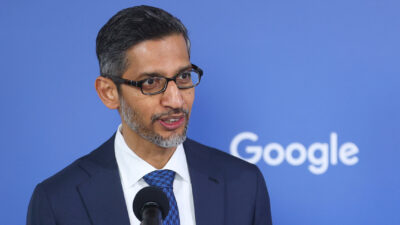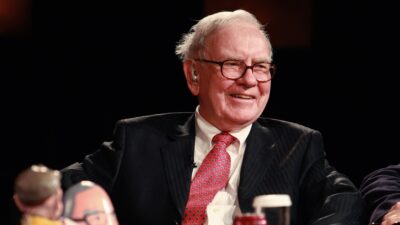Running the Numbers: Will 60/40 Split of Stocks, Bonds Still Yield Retirement Security?
Is Wall Street’s golden ratio, the 60/40 division of portfolios between stocks and bonds, losing its luster?

Sign up for smart news, insights, and analysis on the biggest financial stories of the day.
The origin of the 60/40 strategy lies in the research of American economist Harry Markowitz, a longtime professor of finance at the University of California, San Diego, who died in 2023.
He was renowned for his 1950s work on modern portfolio theory, which argued investors should blend a mix of high-risk, high-return assets with low-risk, low-return assets. For his work on reducing investor exposure to risk through diversification, which was acclaimed for its “algebraic simplicity,” he won the 1990 Nobel Prize in Economics.
By the early 1990s, the 60/40 portfolio had become a go-to interpretation of modern portfolio theory, and Markowitz’s work was widely embraced by individual and institutional investors alike.
The idea is simple: Divide your asset portfolio into 60% equities and 40% fixed-income securities like government bonds, gaining exposure to the high returns of stock market booms while at the same time keeping a foothold in more stable bonds, whose lower but reliable returns can protect your wealth from bear markets.
The 2022 Roadblock
Distant and recent history make a direct case for the 60/40 approach. By measuring past market declines and the amount of time it took to recover from them, Morningstar calculated that the Great Depression was four times more painful for the stock market than it was for a 60/40 portfolio. The Lost Decade of the 2000s, which kicked off with the bursting of the dot-com bubble and ended with the Great Recession, was over seven times as painful for equities.
In other words, even as the 60/40 portfolio has posted less overall growth than the stock market over the course of decades, it has proven more resilient in times of crisis, making it particularly attractive for individual retirement portfolios or pensions designed for stability.
However, 2022 changed the arithmetic. Equities and bonds experienced a simultaneous decline amid two crises: Russia’s full-scale invasion of Ukraine reorganized much of the global economy and energy markets along geopolitical lines, and a supply-chain crisis triggered by the COVID-19 pandemic disrupted global commerce. Both contributed to spiking inflation that has yet to fully subside.
The stock market regained its 2022 high well over a year ago, in September 2024. But the bond market has been a totally different story: It remains underwater. That’s because of the Federal Reserve’s sustained and aggressive interest-rate hikes, which began in March 2022 and have been pared only marginally in the past year.
Bond yields in 2022 were near the lowest in history, which means prices were high because of their inverse relationship with yields. The run of rate hikes, which boosted interest rates from nearly zero to over 4%, caused yields to spike and bond prices to crater.
The bond market’s sustained pain has been so severe, Morningstar noted, that the typical 60/40 portfolio didn’t recover to its 2022 high until June 2025, roughly eight months after equities did so. That marked the only time in a century and a half that the 60/40 portfolio suffered more pain during a downturn than equities.
The Rethink
The chief criticism of the 60/40 portfolio used to be that it offered less exposure to the greater potential upside of equities. Of course, that’s sort of the point, as it’s also meant to blunt their higher risk profile.
But now, increasing attention is being paid to the risk that the economy remains in a state of relatively high inflation with relatively high interest rates. That would maintain pressure on bonds and, naturally, the 60/40 portfolio, prompting suggestions that it’s time for adjustments.
Last month, Morgan Stanley Chief Investment Officer Mike Wilson argued for a new portfolio approach that allocates 60% to equities, 20% to fixed income and 20% to gold.
“Gold is now the anti-fragile asset to own, rather than Treasurys,” he told the Reuters Global Markets Forum. “High-quality equities and gold are the best hedges.”
Spot gold prices have surged 49% this year to record highs of over $3,800 per ounce, and Wall Street expects them to continue rising into next year. Wilson’s argument hinges on the idea that equities are linked to growth and risk tolerance, while gold is a safe-haven asset that traditionally rallies in times of uncertainty and when rates fall.
Last year, Morgan Stanley also suggested that investors consider weighting equities more heavily in their portfolios for a potentially “better risk/reward balance” if generative AI, which has powered the stock market’s rally, continues to thrive and bond markets remain subdued.
Last week, JPMorgan’s private bank arm, which serves high-net-worth individuals, recommended a 60/30/10 portfolio that includes a 10% stake in hedge funds. This mix, the bank said, has outperformed the 60/40 portfolio 70% of the time in the past decade and every year since 2021.
JPMorgan pros also suggested considering investments in private markets, such as private equity, since companies are taking longer to go public than in previous decades, which has reduced the amount of post-IPO value that investors can capture in public markets.
“The median tech IPO is now ~14 years old with ~$220 million in sales compared to ~7 years, and below $20 million in the late 1990s,” the bank’s analysts wrote. “In fact, today’s top private companies (SpaceX, ByteDance, OpenAI) would already rank among the top 30 S&P 500 companies by market cap if they were public.”
That could affect not only institutional investors and pension funds that practice 60/40, but also retail investors, since investment firms have taken steps (some controversially) to increase their access to private markets.
Life Killed 60/40
One final consideration that disrupts the 60/40 strategy, according to Edelman Financial Services cofounder Ric Edelman, is life itself. Or, more accurately, lifespan itself.
“We are living longer than ever before as a species; nowhere in human history have humans lived this long,” he told CNBC in May, noting the previously unthinkable ranks of octogenarians and nonagenarians alive today thanks to improvements in healthcare and living conditions.
The 60/40 portfolio, he said, is “dead because of longevity” and argued a 70% to 80% allocation to equities is a more reasonable ratio for those who want their savings to carry them into old age.
“If you die at 80, it’s not a problem, but if you live to 90 or 100, or 110, it’s an issue,” he added.











